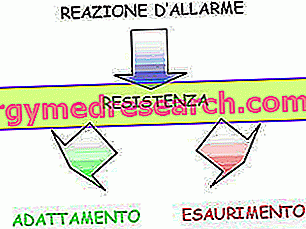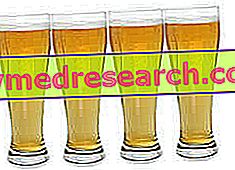By Dott.Luca Franzon
In the age of solo fitness, the new age and the disciplines that train not only the body but also the spirit must become the cultural baggage of the professional in the field, especially the Personal Trainer who has the possibility to work on the person in a more in-depth way than normal instructor. People often say that they practice fitness or any other sport to fight stress and to release tension !!
What is Stress?
We often use the term stress improperly. A first distinction to make is between the words stressor and stress.
THE STRESSOR : it is something that happens to us and can therefore be positive or negative. Noise, sounds, light, heat, cold, chemical additives, viruses, bacteria, family tensions, disturbed relational dynamics, neurotic anxieties etc.
LO STRESS: which in English means effort is the generic answer that our body opposes to the stressor factor.
When a stress process takes place, all the devices and organs used to adapt to the stress factor are called into question in the body.
The endocrine system reacts immediately by modifying the production of various hormones such as: adrenaline and noradrenaline (catecholamines), cortisol, growth hormone (GH) and prolactin which increase rapidly, the thyroid hormones rise more slowly. Sex hormones tend to fall, blood sugar tends to increase, as do cholesterol and triglycerides.
The vegetative nervous system responds with a hyper-stress of the sympathetic system (fight or flight) to enable the organism to cope or avoid the stressful situation as soon as possible. It is said that the autonomic nervous system is like a balance where in one plate there is the orthosympathetic part and in the other the parasympathetic part. As long as the balance is in equilibrium, the subject lives well when one of the two plates becomes heavier, there are two distinct paintings:
- IPERSIMPATICOTONIA
- IPERPARASIMPATICOTONIA
Below are the main changes made by the autonomic nervous system.
| organ | Nice | Parasimpatico |
Heart | Acceleration | Inhibition |
blood vessels
|
|
|
Pupil | expansion | duress |
lacrimal glands | possible secretory function | secretion |
sweat glands | Secretion | none |
hairs of the epidermis | piloerection | none |
adrenal glands | Secretion | none |
Liver | release of glucose | none |
salivary glands | possible secretory function | secretion |
stomach | secretion inhibition and peristalsis | secretion and peristalsis |
intestine | Inhibition | increase in tone and movement |
rectum | Inhibition | faecal expulsion |
Bladder | Inhibition | urine expulsion |
male genitals | ejaculation | erection |
The immune system is also involved. Initially, there may be a decrease in the immune response followed by an increase in antibody production.
Lately we hear a lot about the interaction between the PSYCHO-NEURO-IMMUNO-ENDOCRINE systems involved in the continuous search for homeostasis.
Stress affects our whole body and is something extremely useful as it brings about the phenomenon of adaptation to sudden events. It is of fundamental importance for survival and is called " EUSTRESS ". If the stressor is very intense and the stress is not adapted in a positive way or does so in a prolonged way (chronic stress), the psycho-somatic variations are consolidated bringing the subject to the condition of exhaustion and / or illness. This situation in the long run leads to a decrease in our ability to respond and adapt, the so-called exhaustion syndrome. In this case we will talk about "DIS-STRESS" .
MAIN CLINICAL PANELS PRODUCED BY THE DIS-STRESS |
ANXIETY - INSOMNIA - PANIC - DEPRESSION - FATIGUE - HEADACHE - ARTERIAL HYPERTENSION - LOSS OF MEMORY AND CONCENTRATION - PULPATIONS - MUSCULAR HYPER-NECESSARITY - DISMENORATION - SEXUAL DISORDERS (VAGINISM, EYCULATION, IMPOTENCE) |
The stress that is ultimately defined as the disease of the century has been and is very much studied. the functioning of the stress / stress system has been described as a general adaptation syndrome by the physiologist Hans Selye. This phenomenon is seen as: "... the set of non-specific reactions that the organism opposes to any aggression (trauma, fatigue, anoxia, intoxication, etc ...) to compensate, within certain limits, for physiological alterations derived from the specific situation ". The image below schematically shows what happens every time we are hit by a stressor.

As long as the body is able to adapt and does not give in to the phase of exhaustion, the subject can define himself in homeostasis. The best situation is when the subject can be defined as relaxed.
I make my own the words of Osho Raineesh who in the book "Tantra, the supreme understanding" defines relaxation as follows:
"Relaxation is a state of things in which your energy does not feel the need to go anywhere: it does not go to the future, it does not go to the past; it is simply there with you. The silent pool of your energy, the warmth of your energy, it envelops you. The present moment is everything: there is no other time, time stands still, and there is relaxation, as long as there is time, there is no relaxation. "Steady, time no longer exists. The present moment is everything. Do not ask for anything else, simply enjoy the present. Enjoy the beauty of ordinary things. In reality there is nothing ordinary: if God exists, everything is extraordinary." "
Combat stress with fitness
Moving from theory to practice, I am going to present the relaxation methodology that is the subject of this paper. In this article we talk about the "Progressive muscle relaxation" method developed in the thirties by the American doctor and psychophysiologist Edmund Jacobson and illustrated in 1959 in "How to relax and Have your baby".
The primary objective of any form of relaxation, and of the Jacobson model in particular, is to activate or perhaps it is better to reactivate the parasympathetic system, trying to slow down and contrast the orthosympathetic system that is stressed in stressed subjects and whose activation tends to determine that physiological state that is commonly referred to as an anxiety state. Like all methods and theories, this method also has its pros and cons. In the opinion of many the Jacobson method has the advantage of being able to be used effectively and quickly in every circumstance and in every place. The main disadvantage is that not everyone with this method is able to reach the state of calm, which they can do with other methods such as autogenic training.
The progressive muscular relaxation according to the Jacobson method is subdivided into a general form, which involves the involvement of all the muscle groups, and differential relaxation which instead involves only the involvement of a part of the muscle groups.
The method initially had the big problem that required a total of 56 sessions and exercises that ranged from one to nine hours a day. LaterJ. Wolpe in the 50s and 60s proposed the method in six sessions lasting about thirty minutes. In the last 70 years Bernstein-Barkovec proposed deep muscle relaxation in ten sessions
The method to be effective must follow precise guidelines that are:
- practice regularly and do not spend more than four days between sessions;
- the duration of the session will range from 30 'to 45'
- during the execution of the exercises one must not be disturbed or distracted;
- wear comfortable clothes;
- do it all in a relaxing environment, not too hot, not too cold, quiet and softly lit;
- inhale with your nose to exhale and inhale again only when you feel the real need to do so;
- perform the supine exercises (on a rigid surface) with the arms along the body, legs slightly apart, feet relaxed.
Total relaxation
X Problems with video playback? Reload from YouTube Go to Video Page Watch the video on youtubeExercises:
- LEGS:
- extend the toes. Maintain the tension 2 seconds if the muscles are not trained, otherwise from 2 to 6 seconds. Leave and relax for about 15 seconds.
- flex the toes and try to touch the floor with the sole of the foot. Maintain the tension 2 seconds if the muscles are not trained, otherwise from 2 to 6 seconds. Leave and relax for about 15 seconds.
- Contract the leg muscles with a hammer foot. Maintain the tension 2 seconds if the muscles are not trained, otherwise from 2 to 6 seconds. Leave and relax for about 15 seconds.
- Maintain the tension 2 seconds if the muscles are not trained, otherwise from 2 to 6 seconds. Leave and relax for about 15 seconds. Proceed first with one leg then with the other.
- BUTTOCKS: Contracting the buttocks. Maintain the tension 2 seconds if the muscles are not trained, otherwise from 2 to 6 seconds. Leave and relax for about 15 seconds.
- ABDOMINALS: Contract the abdominal muscles, retracting the belly. Maintain the tension 2 seconds if the muscles are not trained, otherwise from 2 to 6 seconds. Leave and relax for about 15 seconds.
- ARMS: Tighten the fist firmly and bend the forearm on the arm, maintaining tension, trying to reach the shoulder with the wrist. Maintain the tension 2 seconds if the muscles are not trained, otherwise from 2 to 6 seconds. Leave and relax for about 15 seconds. Lay the arm on the ground again and relax.
- BACK AND SHOULDERS: Push the upper limbs against the hips and simultaneously place the shoulders down and forward. Maintain the tension 2 seconds if the muscles are not trained, otherwise from 2 to 6 seconds. Leave and relax for about 15 seconds.
- NUCA: bring the shoulders upwards until the head interlocks between them and contract. Maintain the tension 2 seconds if the muscles are not trained, otherwise from 2 to 6 seconds. Leave and relax for about 15 seconds.
- FACE: curl the forehead, close the eyelids and tighten the lips as much as possible. Maintain the tension 2 seconds if the muscles are not trained, otherwise from 2 to 6 seconds. Leave and relax for about 15 seconds.
Eventually lie down for a few minutes enjoying deep relaxation. It is recommended to finish the exercises with slow but accentuated breathing.
Apparently it is a simple method, but since it goes to act on multiple levels and apparatuses of the body it is not to be underestimated or to be recklessly practiced. Sometimes for the first sessions it would be good to ask for help from an experienced therapist. A possible contraindication of progressive muscle relaxation is the onset of cramps. If you feel pain while performing the exercises you need to decrease the intensity of the contraction.
At this point you just have to try with the hope that you could relax or relax your customers ..... !!!



